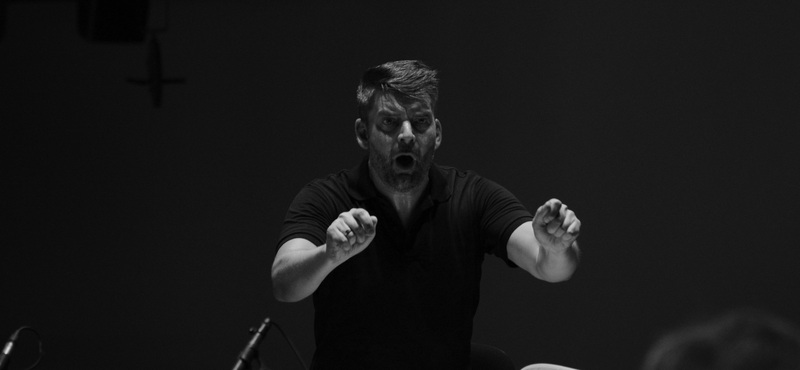John Luther Adams sets the BSO Adrift

Pablo Ferrández and Dvořák come their rescue.
The expression of relief on the Baltimore Symphony Orchestra musicians’ faces after intermission last night at Strathmore, as they settled into the opening of the Dvořák Cello Concerto, was vivid. “Finally . . . music!” they seemed to be saying, and leaned into all of the expressive elements with gratitude. You see, they had just been through 42 minutes of near-torture; Become Ocean, by John Luther Adams (no relation to John Adams), which the composer describes as “a meditation on the vast, deep and mysterious tides of existence,” which guest conductor Kwamé Ryan in his pre-concert remarks called “a kind of acoustical installation,” and which I’d describe simply as musical sewage.
The work, for a very large orchestra including four harps, rafts of percussion, two keyboard instruments, and electronics piped in through four speakers, is a virtually unchanging, gurgling stew of sound; there are many, many notes in it but all subsumed into three instrumental choirs whose materials overlap asymmetrically, and half-way through are played backwards, resulting in a musical palindrome. This last observation came from reading the program; there is not one, single identifiable musical idea in the piece; the texture simple ebbed and flowed, sometimes loudly, sometime softly. There was no rhythm and no melody; to the extent there was harmony, it was a shimmering, euphonious, diatonic chord, which slowly changed shape somewhat like an aural lava lamp. And so it went for (in case you missed it) 42 minutes.
This all would have been fine for five minutes, for example as an entr’acte to a modern opera or ballet scene (with actual music to follow). But as it slowly dawned on the audience that there was nothing else and that they would slowly drown in this, the air went out of the room. We’ve heard similar stuff before, from Górecki, Glass, and Pärt, among others, but I can’t recall anything from them of this length with this little substance. We all know that the Pulitzer Prize in music has long been an effete joke (final awards made by non-musicians), but seeing that honor attached to this work (which also won a Grammy!) was a true capstone.
The poor BSO musicians had to play with stand lights so we could appreciate the diaphanous blue lighting design that played behind the orchestra. You could see the various sections noodling away on repetitive passage-work, though nothing audible ever emerged from the soup. One couldn’t tell what was coming out of the loudspeakers vs. what was coming out of the orchestra, which vividly called up the most pressing existential question for “music” of this ilk: why are you making humans play it? The piece was obviously created on a computer; modern audio equipment and software can produce a far wider palette of sounds than a traditional orchestra can, and the human element was all but eliminated anyway, as Ryan had to conduct with an earpiece in, to ensure that he kept the live musicians in sync with the electronics. All of this for what?
There are so many fine hydrographic works out there; mighty oceans and rivers have inspired great art, whether the Rhinegold Prelude, La Mer, or countless others. If, as the program notes suggest, Become Ocean is in part an environmental protest, there are any number of things Adams could have done instead. How about a “pollution” theme, contrasting with a “whale” motif, that becomes distorted into an “overfishing” section, with perhaps a battle scene involving Somalian pirates? The possibilities are endless, but instead we got something that called to mind Mark Twain’s description of the Book of Mormon – “chloroform in print.”
Cellist Pablo Ferrández is a very gifted player. Like Han Na Chang and Gautier Capuçon, he is a small person who has discovered the secret to producing a large sound, something that eludes many taller cellists. From first note to last, he put his entire back into the bowing, and filled the hall; in the big duet near the end, he all but drowned out the BSO concertmaster. This came at the cost of subtlety and color, though. The imperatives of cutting through a large orchestra means that musical gestures and phrasing have to be exaggerated, and in Ferrández ’s case this meant inserting agogics and tempo-changes that often broke up Dvorak’s larger structures. His left hand, though remarkably accurate intonation-wise, could get ahead of itself, blurring some of the fastest passages in the finale. And his trills were of the “vibrato” variety rather than independent finger actions; just a small irritant, and again likely a side-effect of his admirable focus on projection, but noticeable. All in all, though, an excellent rendition by a young prince of the cello. Ryan accompanied well, with some careful shaping, and the BSO, as I said, played with grateful fervor, despite some intonation problems in the horns.
The program will be repeated tomorrow and Sunday at Meyerhoff Hall in Baltimore.
Pictured: Kwame Ryan, Klaus Frohlich Photography & Pablo Fernandez, Igor Studio.






